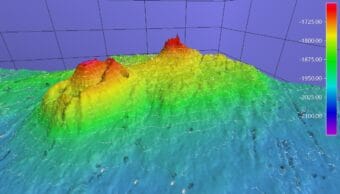
Four Aleutian volcanoes have been under elevated alert levels for about a year. Now they’ve been joined by a fifth.
The new one is Takawangha, which rises 4,753 feet out of the Bering Sea in the far western Aleutians.
The Alaska Volcano Observatory put Takawangha on its watch list when a swarm of earthquakes with magnitudes between two and three intensified around the volcano.
John Lyons, a research geophysicist at AVO, said swarms often point to volcanic activity.
“That typically indicates that there’s been magma or volcanic fluid there,” Lyons said. “A swarm of earthquakes can often precede activity at the surface, including an eruption.”
The swarm began on Nov. 18, prompting the Alaska Volcano Observatory to move the volcano’s aviation color code to yellow, which means it’s showing elevated levels of activity but not erupting.

The other four volcanoes are Great Sitkin, Cleveland, Pavlof and Semisopochnoi. Most have been moving in and out of the yellow and orange advisory levels. “Orange” means that an eruption is likely or already happening, but it’s not creating major hazards.
Five volcanoes rumbling at the same time might sound like a lot, but Lyons said it’s not uncommon for the state.
“There’s so many active volcanoes in Alaska, having five that have an elevated color code isn’t really extraordinary,” Lyons said.
Takawangha is about 55 miles west of Adak and could threaten the city of around 200 people should it erupt, but Lyons said the current advisory level is no cause for concern.
“The potential hazard to people in Adak is very low right now. And because the volcano is so well monitored, and because the Alaska Volcano Observatory is keeping an eye on it, there will be signs and we will catch those signs and put out timely notices if there’s any change in activity,” he said.
As of Monday, the swarm was still continuing at Takawangha and the color code remained at yellow.


